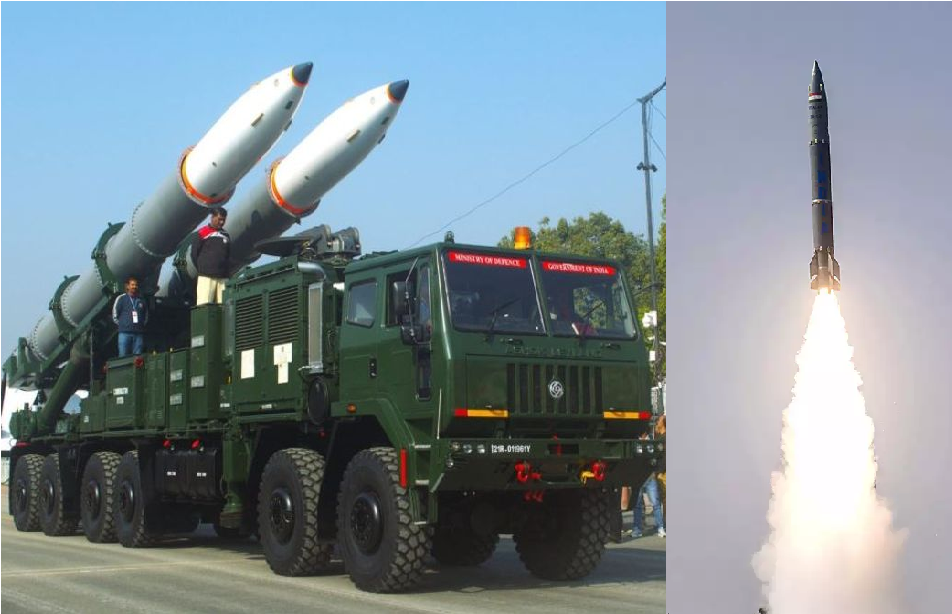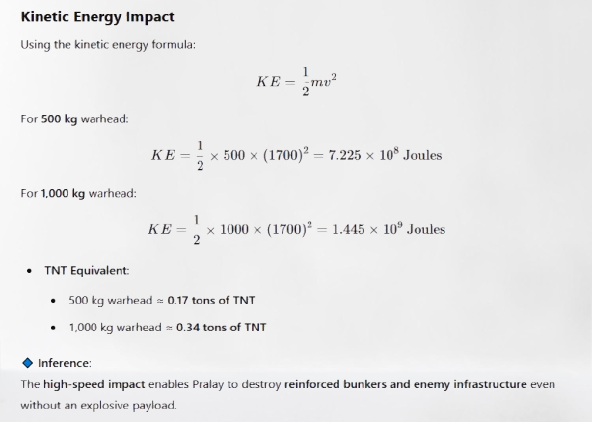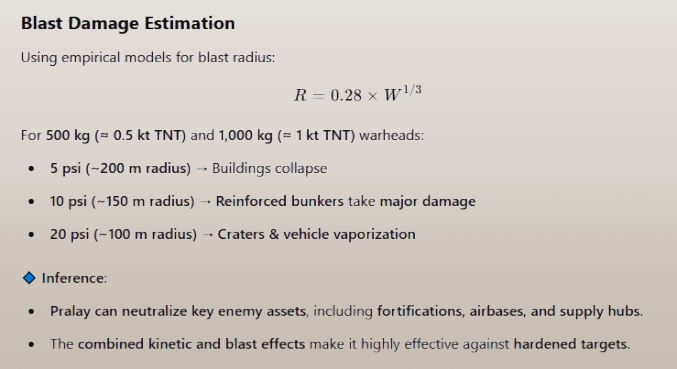
- India’s defence capabilities have advanced significantly with the Pralay missile, which represents a major step in fortifying the nation’s reaction and strategic deterrence systems.
- With an effective range of 150–500 kilometres, the Pralay missile can precisely target military installations and vital infrastructure.
- Economic centres like Pakistan’s key industrial zones, Karachi Port, and Gwadar Port, as well as China’s semiconductor manufacturing plants in Shenzhen, Shanghai, and Chengdu, are within the reach of Pralay which can cause devastating losses.
- Pralay guarantees defensive readiness in the event of external threats, notwithstanding the adversary’s advanced defence systems and its demands for evolutionary warfare.
The Defence Research and Development Organization (DRDO) of India created the Pralay, an all-weather, surface-to-surface short-range tactical missile that can carry out accurate and timely strikes with conventional weapons. This missile is a significant asset to India’s defence capabilities. This missile was created to improve India’s ability to respond to conflicts, particularly in areas along the LAC and LAC across from China and Pakistan. As a result, India is better equipped to handle threats from these two neighbours.
With a development budget of ₹332.88 crore, the missile project got underway in 2015 and was followed by practical operating tests. Successful testing in December 2021 and December 2022 demonstrated accuracy while interacting with targets that were 150–500 kilometres away. In December 2022, the Indian Air Force ordered 120 Pralay missiles, and in 2023, the Indian Army ordered another 250. After being added to the normal military inventory, the Indian Army authorized the procurement of a regiment of Pralay missiles on September 19, 2023.
Given that the Indian Armed Forces most likely plan to station the Pralay missile along the LAC, particularly across from China, some strategic missile deployment is probably going to occur in critical places. India can swiftly destroy military sites and resort facilities due to its range and ability to carry conventional warheads. Later in 2025, deliveries to the Indian Air Force might begin, significantly strengthening India’s defence stance.
The Pralay missile’s introduction brings an impactful change to India’s military approach. While combat service-ready, it functions as a flexible military tool for conventional strikes and additively modifies the deterrence capabilities. Pralay is a formidable weapon for combat because of its solid propellant motor, proven accuracy, and capacity to avoid contemporary air defence systems. It is anticipated that its introduction will increase India’s preparedness for threats to regional security.
Key Features
With an effective range of 150–500 kilometres, the Pralay missile can precisely target military installations and vital infrastructure. Its solid propellant rocket motor provides high-speed travel and quick deployment, making it difficult for adversary air defence systems to intercept it. With a Circular Error Probability (CEP) of 10 meters for pinpoint accuracy, its dual-mode guiding system uses radar imaging for terminal homing and inertial navigation for mid-flight modifications. Furthermore, it can carry conventional warheads with a mass of 350–700 kg, such as PCB, RDPS, and high-explosive warheads, providing a range of target options.
Countering Air Defense Systems
Pralay is made to get past advanced air defence systems by:
- The Quasi-Ballistic Path: It is difficult for opposing air defence systems to track and intercept a low, curving flight path.
- Mid-Flight Medium-Range Guided Missile: Pralay modifies its trajectory to avoid the attack since it is a manoeuvrable reentry vehicle (MaRV).
- Pralay increases the likelihood of a successful impact by using decoys to disrupt adversary radar, similar to Russia’s Iskander-M missile that uses decoy fusers.
Methodology for Missile Impact and Destruction Analysis


Impact Analysis on Pakistan and China
There would be significant damage, financial losses, and operational disruptions from a missile strike on China’s and Pakistan’s vital military and commercial infrastructure. The PLA headquarters in Beijing, Southern Theater Command in Guangzhou, Yulin Naval Base, and Qingdao Naval Base in China, as well as PAF Base Sargodha, Naval Base Karachi, and GHQ Rawalpindi in Pakistan, would all sustain significant damage within a 200-meter blast radius, severely hindering defence operations. Their national security readiness would be impacted by the disruption of military planning and coordination caused by the destruction of command centres.
Economic centres like Pakistan’s key industrial zones, Karachi Port, and Gwadar Port, as well as China’s semiconductor manufacturing plants in Shenzhen, Shanghai, and Chengdu, would suffer devastating losses. A missile strike on these sites would stop trade and production by destroying cargo, industrial complexes, and vital logistical operations. Considering the trade volumes and economic importance of these hubs, the predicted financial losses could amount to billions of dollars.
Widespread blackouts, power shortages, and in severe cases, flooding from dam breaches would affect both countries’ energy infrastructure, including the Three Gorges Dam, Daya Bay Nuclear Plant, and major oil reserves in Xinjiang, China; and the Tarbela and Mangla Dams, Hub Power Plant, and Sahiwal Coal Power Plant in Pakistan. Devastating floods will arise from the breach of the Three Gorges Dam or Tarbela, uprooting thousands of people and wreaking havoc downstream.
There will be major disruptions to China’s Beidou Satellite Ground Stations and important transportation facilities, as well as to Pakistan’s Islamabad International Airport, M-2 Motorway, and important railway intersections. Travel and logistics would be halted by damage to airports and railway terminals, which would cause supply chain disruptions and economic slowdowns. Communication capabilities, military intelligence, and cyber operations would all be impacted if China’s satellite ground stations and cyberwarfare command centres were destroyed.
Simulation of Pralay Missile Strike
Launched 300 kilometres afar, a Pralay missile ascends 50 kilometres before swiftly falling. It is detected by enemy radar, which has ninety seconds to react. Its quasi-ballistic trajectory guarantees successful evasion despite S-400 defenses. The runway was rendered inoperable for more than 48 hours when the 1,000 kg warhead struck with 1.44 × 10⁹ J energy, forming a crater that was 15 meters broad and 4 meters deep. The radar is rendered inoperable, hangars collapse, and fuel depots are ignited inside the 280-meter blast radius. Devastation is increased by secondary explosions.
Deaths happen instantly within 100 meters; serious injuries happen within 500 meters. Enemy forces are forced to move their activities due to the compromised communications and fuel supplies. India gains a tactical success when the airbase is rendered inoperable for three to five days due to the destruction of five to ten aircraft, the burning of two fuel dumps, and more than 100 casualties.
Strategic and National Security Value
India’s defence strategy has undergone a significant change with the introduction of Pralay, which increases the nation’s ability to deter and improves operational flexibility. It may swiftly launch precise retaliatory strikes due to its 500 km range, particularly along the delicate LAC and LoC. Pralay is designed to destroy enemy infrastructure, military installations, and command centres. If desired, the induction of Pralay might be a vital weapon in contemporary warfare.
Additionally, the capacity to defeat contemporary air defence systems strengthens India’s defensive posture by guaranteeing that its conventional strike capabilities remain effective even in the face of cutting-edge missile defence technology. During the Republic Day parade on January 26, 2023, the missile demonstration demonstrated India’s growing defence independence and technological prowess, sending a clear message to its neighbours that it is prepared to confront foreign threats with cutting-edge, adaptable military hardware.
Conclusion
India’s defence capabilities have advanced significantly with the Pralay missile, which represents a major step in fortifying the nation’s reaction and strategic deterrence systems. India has a powerful instrument to counter threats from regional enemies thanks to its accuracy, adaptability, and capacity to get past contemporary air defence systems. India’s ability to quickly carry out strikes that can directly affect current border areas along the LAC and LoC will be improved by Pralay’s successful integration into the nation’s arsenal. This would demonstrate India’s growing technical sovereignty in the global defence architecture in addition to strengthening its defensive position. Pralay guarantees defensive readiness in the event of external threats, notwithstanding the adversary’s advanced defence systems and its demands for evolutionary warfare. Its incorporation into India’s defence strategy amplifies the nation’s commitment to security and interest in cutting-edge, high-impact military assets, thereby sending a strong message of readiness and decisiveness.
References:
- https://en.wikipedia.org/wiki/Pralay_(missile)
- https://www.business-standard.com/external-affairs-defence-security/news/india-s-pralay-missile-debuts-on-r-day-closing-gap-with-china-pakistan-125012700869_1.html
- https://www.drishtiias.com/daily-updates/daily-news-analysis/pralay-missile-1/print_manually
- https://armyrecognition.com/news/army-news/2025/india-to-deploy-new-pralay-twin-ballistic-missile-launcher-near-borders-with-china-and-pakistan
- https://idrw.org/india-plans-to-deploy-pralay-tactical-missiles-to-counter-northern-border-threats/
Piyush Anand is a Biotechnology Engineering student at Chandigarh University. His primary interest lies in International Affairs, Defence and Strategy. Views expressed are the author’s own.
